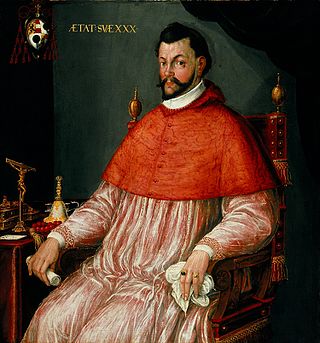
Salzburg is the fourth-largest city in Austria. In 2020, it had a population of 156,872.

The Prince-Archbishopric of Salzburg was an ecclesiastical principality and state of the Holy Roman Empire. It comprised the secular territory ruled by the archbishops of Salzburg, as distinguished from the much larger Catholic diocese founded in 739 by Saint Boniface in the German stem duchy of Bavaria. The capital of the archbishopric was Salzburg, the former Roman city of Iuvavum.

The University of Salzburg, also known as the Paris Lodron University of Salzburg, is an Austrian public university in Salzburg municipality, Salzburg State, named after its founder, Prince-Archbishop Paris Lodron.

Salzburg Cathedral is the seventeenth-century Baroque cathedral of the Roman Catholic Archdiocese of Salzburg in the city of Salzburg, Austria, dedicated to Saint Rupert and Saint Vergilius. Saint Rupert founded the church in 774 on the remnants of a Roman town, and the cathedral was rebuilt in 1181 after a fire. In the seventeenth century, the cathedral was completely rebuilt in the Baroque style under Prince-Bishop Wolf Dietrich von Raitenau to its present appearance. Salzburg Cathedral still contains the baptismal font in which composer Wolfgang Amadeus Mozart was baptized.

The Bishop of Gurk is the head of the Roman Catholic Diocese of Gurk, which was established by Archbishop Gebhard of Salzburg, in 1072, as the first suffragan bishop in the Duchy of Carinthia.

Louis VI, Elector Palatine, was an Elector from the Palatinate-Simmern branch of the house of Wittelsbach. He was the first-born son of Frederick III, Elector Palatine and Marie of Brandenburg-Kulmbach.

The Diocese of Graz-Seckau is a Latin Church diocese of the Catholic Church comprising the Austrian state of Styria. It is part of the Ecclesiastical Province of Salzburg.
Grödig is a market town of Salzburg-Umgebung District in the state of Salzburg in Austria.

The Archdiocese of Salzburg is a Latin Church archdiocese of the Catholic Church in Austria. The archdiocese is one of two Austrian archdioceses, serving alongside the Archdiocese of Vienna.

Mirabell Palace is a historic building in the city of Salzburg, Austria. The palace with its gardens is a listed cultural heritage monument and part of the Historic Centre of the City of Salzburg UNESCO World Heritage Site.

The Mönchsberg, at 508 meters (1,667 ft) above sea level, is one of five mountains in the city of Salzburg in Austria. It flanks the western side of Salzburg's historic city centre, and forms part of the city's UNESCO World Heritage Site.

Wolf Dietrich von Raitenau was Prince-Archbishop of Salzburg from 1587 to 1612.

Hieronymus Joseph Franz de Paula Graf Colloredo von Wallsee und Melz was Prince-Bishop of Gurk from 1761 to 1772 and Prince-Archbishop of Salzburg from 1772 until 1803, when the prince-archbishopric was secularized. After secularization, Colloredo fled to Vienna and remained the non-resident archbishop of Salzburg, bereft of temporal power, until his death in 1812. He is most famously known as a patron and employer for Mozart.

StefanoBernardi, also known as "il Moretto", was an Italian priest, composer and music theorist. Born in Verona and maestro di cappella at the Verona Cathedral from 1611 to 1622, he later moved to Salzburg, where he was responsible for the music at the Salzburg Cathedral and composed a Te Deum for 12 choirs performed at the cathedral's consecration in 1628.

Mark Sittich von Hohenems was Prince-Archbishop of Salzburg from 1612 until his death.

Salome Alt, was the mistress to Wolf Dietrich von Raitenau, reigning Prince-Archbishop of Salzburg, from about 1593 until 1617.

Johann IV of Osnabrück was a German nobleman and prince-bishop. From his father Johann VII's death in 1535 onwards he was known as Count (Graf) Johann VIII von Hoya zu Stolzenau. From 1553 he was Prince-Bishop of Osnabrück, then from 1566 Prince-Bishop of Münster and finally from 1568 administrator of the Bishopric of Paderborn.

Altenau Palace was a palace in Salzburg, Austria. Built in 1606, it was demolished in the 1720s to make way for the Mirabell Palace which stands on the same site. It was the home of prince-archbishop Wolf Dietrich von Raitenau.

Schloss Blühnbach is a stately home in the Blühnbach valley in Werfen, Salzburg (state), Austria. Formerly, it was a hunting lodge of the Prince-Archbishops of Salzburg and Archduke Franz Ferdinand of Austria, heir to the Austro-Hungarian throne, whose assassination in Sarajevo triggered World War I. The estate is privately owned and ‘hermetically closed’ to the public.

























